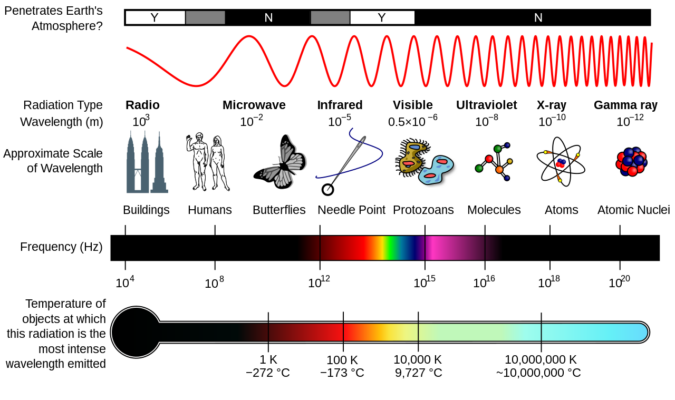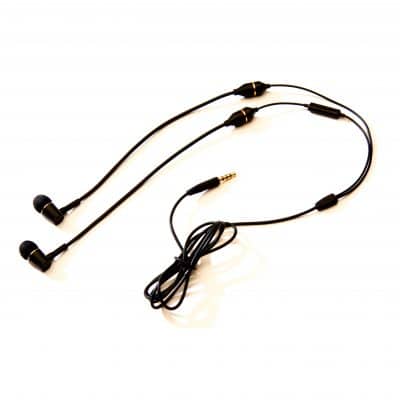The WaveWall Blog
AirPod Radiation – Is it Safe?
AirPods were initially released in 2016 and now, millions of people use them daily. Apple allegedly sold around 20 million pairs in Q1 2022 alone, and they are undoubtedly the most popular Bluetooth earphones around.
Bluetooth has evolved to support the need for stable media connections, with stronger transmitters that enable device communication over hundreds of feet.
The concern surrounding Bluetooth earphones and the radiation they emit is that they’re so close to the brain. They literally sit inside the ear canal – you can’t get much closer than that!
In this article, we will explore the science behind AirPod radiation, the potential health effects, and ways to reduce exposure.
Table of Contents
What is Electromagnetic Radiation?
All electronic devices, such as smartphones, tablets, and wireless earbuds, emit some level of electromagnetic radiation.
These electromagnetic fields (EMF) are grouped into two broad categories depending on their positon on the electromagnetic spectrum:
- Non-ionising: Low-level radiation which is generally viewed as harmless, e.g. radio waves.
- Ionising: Powerful, short wavelength radiation with the potential for cellular and DNA damage, e.g. gamma rays.

Until the 1950s or so, most research into radiation was focused on ionising varieties of radiation. These are certainly the most harmful. On the other hand, non-ionizing radiation was more or less assumed to be safe.
Today, the scientific community is growing more sceptical about the effects of non-ionising radiation produced by phones, wireless earbuds and many other electrical devices. The WHO officially classed cellphone radiation as a grade 2B Possible Carcinogen:
“The working group reached the conclusion that RF radiation from devices that emit non-ionizing RF radiation in the frequency range 30 kHz-300 GHz, is a Group 2B, i.e. a ‘possible’, human carcinogen” – Hardell, 2017.
Meanwhile, the Bioinitiative Report written in 2012 by 29 scientists in total reviewed 1800 studies on EMF and various subjects related to wireless technology and radiation and urged new protective measures to warn the public of the dangers of EMF.
Concerns were stepped up a notch when 250 scientists formed the EMF International Appeal Scientists call for Protection from Non-ionizing Electromagnetic Field Exposure that highlights the requirement for more rigid rules governing EMF.
What are the Dangers of EMF?
There are plenty of reputable peer-reviewed studies on EMF and its potential for harming human health. WaveWall has collected some of the more well-known papers here.
Here’s a brief rundown of what we know:
- Drastic increases in glioblastoma and other rare auditory and brain tumours are possibly linked to mobile phone radiation. For example, Glioblastoma rates have doubled in 20 years.
- Breast cancer rates have increased, with some studies attributing this to mobile phone storage in bras.
- Increased rates of testicular cancer
- Infertility and impaired sperm health
- Heart problems and an increase in rare heart cancers
- For an overview of studies, head here

It’s worth noting that, as of 2023, there is no absolute clarity on some of the above. It’s extremely difficult to “rule in” phone radiation without ruling other factors out completely.
However, it’s hard to refute that mobile phones and other electronic devices like AirPods are having some level of impact. Just because we don’t know for sure doesn’t mean it’s not as bad as some argue.
AirPod Radiation: What You Need to Know
AirPods emit non-ionizing radiation, mostly in the radiofrequency (RF) part of the spectrum. The RF radiation emitted by AirPods has increased over time as Bluetooth becomes more powerful.
In fact, modern Bluetooth transmitters are almost 100 times more capable than some of the older generations.
All Apple Airpods carry powerful Class 1 transmitters, the maximum power in use commercially.
So, how much radiation do AirPods emit?
AirPod Radiation and Specific Absorption Rates (SAR)
The Specific Absorption Rate (SAR) is a measure of the amount of electromagnetic radiation that is absorbed by the body when using a wireless device, such as AirPods.
SAR is measured in watts per kilogram (W/kg). The Federal Communications Commission (FCC) in the United States has established SAR limits of 1.6 W/kg for head and body exposure, whereas the EU uses a higher 2.0W/kg.
There is limited evidence of AirPod SAR on the company’s official website – which does seem peculiar, as phones are clearly listed with SAR values.
Secondary sources state the SAR value for AirPods is 0.466 W/kg when tested at a distance of 5 mm from the ear.
Another found 0.58W/kg for the right AirPod and 0.50W/Kg for the left. Filings with the FCC show 0.097W/kg and 0.072W/kg.
You can view these here, though they’re not easy to interpret.
Additionally, this SAR value is based on the assumption that AirPods are used within their recommended range of up to 10 metres (33 feet) from the connected device.
A Lack of Clarity
Aside from the lack of clarity, it’s striking that radiation is measured at 5 mm from the ear when the earphone clearly sits directly inside the ear canal. In addition, Apple’s filing information clearly shows a high area of EMF exposure directly around the head, which is where AirPods are used.

Moreover, EMF is thought to be readily absorbed by bone, but virtually no bone intercepts the ear canal and brain.
It’s important to note that, while radiation is emitted from the speakers of any headphones – wireless or not – AirPods and other wireless in-ear headphones use wireless technology, which greatly compounds the issue.
Health Consequences of AirPods
The dangers of AirPods and other wireless headphones haven’t gone unnoticed. In fact, Reuters launched a “fact check” into media claims that AirPods were harmful and predictably branded the claims “False” because the measurements fell within legal limits.
It’s worth pointing out, however, that regulatory EMF levels have come under fire for being far too liberal. And the SAR test procedure itself has been criticised. You can read more about these issues here.
Additionally, some experts suggest that the proximity of wireless earbuds to the brain may increase the risk of brain tumours.
Further research suggests that the absorption of RF radiation by the human body is higher in children than in adults due to their thinner skulls and developing brains.
Therefore, parents should be particularly cautious when it comes to allowing their children to use wireless earbuds.
Scientific Opinions
Here are some opinions from leading researchers and industry experts.
Professor of biochemistry Jerry Phillips at the University of Colorado spoke to Business Insider about AirPods, stating:
“My concern for AirPods is that their placement in the ear canal exposes tissues in the head to relatively high levels of radio-frequency radiation.”
Indeed, the brain is very much exposed to radiation entering through the ear. However, the structures here are small and likely don’t block or diffuse much radiation.
Dr Joel Moskowitz, from the School of Public Health at the University of California, Berkeley, stated:
“For some Bluetooth devices like Apple’s AirPods, the Specific Absorption Rate (SAR), a measure of the body’s maximum exposure to microwave radiation, exceeds that of many smart phones.”
“Moreover, the cumulative exposure to radiation from wireless headsets may be substantial since many users keep these devices on their head for hours at a time.”
This is a highly salient point – people may live and work with their AirPods all day. So even when nothing is playing through them, they’re still actively connected to your phone.
AirPod Radiation: Ways to Reduce Exposure
1: Limit Use:
First things first, consider removing AirPods when you’re not using them. Even when no media plays through them, they still communicate with your phone.
Using AirPods only when necessary and for short periods helps reduce exposure.
2: Reduce General EMF Exposure
There are many other ways to reduce general exposure to EMF, such as reducing phone usage, using radiation-blocking phone cases, moving your WiFi router away from sleeping and living areas and turning the router off when not in use.
3: Use Anti-Radiation Headphones
Special headphones like the WaveWall Airtubes are wired headphones designed to stop radiation from travelling up headphone wires.
Yes – wired headphones may draw radiation from your phone into the earphone itself. This is because the headphone wire essentially acts as an antenna.
WaveWall Airtubes prevent this by blocking the radiation with an innovative air chamber which lets sound vibrations pass through.

Summary: AirPod Radiation – Is it Safe?
AirPods emit non-ionizing radiation in the radio frequency and microwave range.
The amount of RF radiation emitted by AirPods is compounded by their proximity to the brain.
Scientific studies reveal EMFs’ harmful potential, and common sense dictates that beaming radiation into the brain is not sensible!
AirPods are exceptionally popular, and many people use them throughout the day. To reduce exposure to AirPod radiation, limit use and use EMF radiation shielding products to reduce your overall exposure.
Consider the WaveWall Airtubes, which block 99% of radiation from travelling up to your brain.

